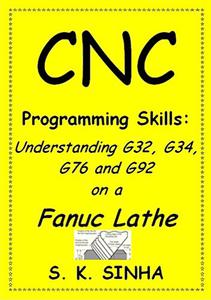

E-Books →CNC Programming Skills Understanding G32, G34, G76 and G92 on a Fanuc Lathe
Published by: voska89 on 15-08-2022, 03:38 |  0
0

S. K. Sinha, "CNC Programming Skills: Understanding G32, G34, G76 and G92 on a Fanuc Lathe"
English | 2016 | ASIN: B01C7T04OI | EPUB | pages: 47 | 0.3 mb
This is the fifth e-book in the series, "CNC Programming Skills." It explains the use of G32, G34, G92 and G76 for thread machining on an i-series Fanuc lathe or a similar control.
While information about these G codes are freely available in books and several online CNC forums, these are in scattered form, and many a time, not very clear. The present book is a comprehensive source of information about thread machining on a lathe. Apart from the usual descriptions, it also discusses some lesser known techniques such as thread machining using two tools at different RPMs.
This book is written keeping in view the requirements and expectations of beginners who wish to learn on their own with no helping hand available to them. No background is assumed. It even explains the thread nomenclature in the beginning. One only needs to have prior knowledge of basic codes such as G00 and G01 for following the book. Read on and find out yourself. Watch yourself growing into an expert programmer!
The following excerpts from the book would give some idea of the way of presentation:
Syntax:
It is a two-block canned cycle belonging to G-code Group 0, along with other non-modal (one-shot) codes such as G70−G75:
G76 P_ _ _ _ _ _ Q_ R_;
G76 X(U)_ Z(W)_ P_ Q_ R_ F_;
The first two digits of P (in the first block) are the number of finishing passes (01 to 99 allowed).
The middle two digits of P, divided by 10 and multiplied by the lead, is the chamfer distance (00 to 99 allowed). Parameter 5130, described earlier, automatically gets overwritten by the specified value. Therefore, if a G92 cycle is executed subsequently, it would use the modified chamfer distance.
The last two digits of P is the angle of the thread (80º, 60º, 55º, 30º, 29º or 0º can be selected).
Q in the first block is the minimum depth of cut in microns (in mm mode), beyond which the depth of cut is not decreased even if the value calculated by the control comes out to be smaller than this.
R in the first block is the finishing allowance on diameter.
X(U) Z(W) is the target point, i.e., the radial and the axial end of the thread, as with G92. Thus, X is the core diameter of an external thread, and the root diameter of an internal thread.
P is the height of the thread in microns (in mm mode) which can be read from threading charts, corresponding to the given outer diameter of the thread.
Q in the second block is the first depth of cut in microns (in mm mode) which applies to the first roughing pass only.
R in the second block is the taper amount on radius, as with G92.
F is the lead of the thread (= Pitch x Number of starts)
Least-Input-Increment data:
Q in the first block, and both P and Q in the second block do not accept decimal digits. These are specified in multiples of the least input increment being used on the machine, without a decimal point. Thus, in millimeter mode, micron (0.001 mm) is used, and in inch mode, ten-thousandth of an inch (i.e., 0.0001 inch) is used, for the commonly used increment system, IS-B. For example, for 0.5 mm, Q500 is programmed in millimeter mode. In inch mode, for 0.05 inch, Q0500 (or simply Q500) is programmed. Leading zero(es) can be omitted.
Roughing/Finishing Passes:
The first depth of cut, which locates the first roughing pass, is measured from the outer diameter (bore diameter, in the case of an internal thread). The control calculates the outer diameter by adding twice the height of the threads to the core diameter. Bore diameter is calculated by subtracting twice the height of the threads from the root diameter. This is the reason why the height of the thread is required to be specified in this cycle. The last roughing pass is at the level of the core diameter plus the finishing allowance (root diameter minus the finishing allowance, in the case of an internal thread). The total number of roughing passes is decided by the control, based on the height of the thread, and the first and the minimum depth of cuts ...
Buy Premium From My Links To Get Resumable Support,Max Speed & Support Me
Download From UploadCloud
https://www.uploadcloud.pro/cbv5z9jmuya8/lv0ng.C.P.S.U.G.G.G.a.G.o.a.F.L.rar.html
Download From NovaFile
https://nfile.cc/9j7eAKrL/lv0ng.C.P.S.U.G.G.G.a.G.o.a.F.L.rar

https://rapidgator.net/file/0e7be7f9348107e6a9d9925d4f8a12b3/lv0ng.C.P.S.U.G.G.G.a.G.o.a.F.L.rar.html

https://nitroflare.com/view/290568146933075/lv0ng.C.P.S.U.G.G.G.a.G.o.a.F.L.rar

https://uploadgig.com/file/download/7cA4bdF733ba66d0/lv0ng.C.P.S.U.G.G.G.a.G.o.a.F.L.rar
https://www.uploadcloud.pro/cbv5z9jmuya8/lv0ng.C.P.S.U.G.G.G.a.G.o.a.F.L.rar.html
Download From NovaFile
https://nfile.cc/9j7eAKrL/lv0ng.C.P.S.U.G.G.G.a.G.o.a.F.L.rar

https://rapidgator.net/file/0e7be7f9348107e6a9d9925d4f8a12b3/lv0ng.C.P.S.U.G.G.G.a.G.o.a.F.L.rar.html

https://nitroflare.com/view/290568146933075/lv0ng.C.P.S.U.G.G.G.a.G.o.a.F.L.rar

https://uploadgig.com/file/download/7cA4bdF733ba66d0/lv0ng.C.P.S.U.G.G.G.a.G.o.a.F.L.rar
Links are Interchangeable - No Password - Single Extraction
Related News
-
{related-news}

